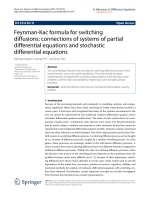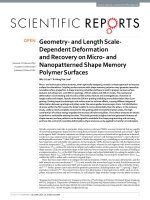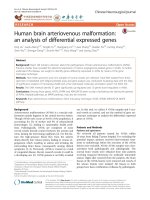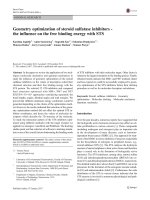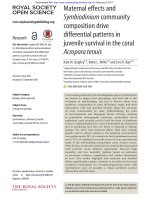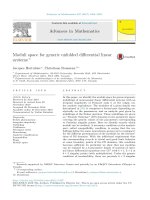Differential geometry erwin kreyszig
Bạn đang xem bản rút gọn của tài liệu. Xem và tải ngay bản đầy đủ của tài liệu tại đây (16.74 MB, 384 trang )
DIFFERENTIAL
GEOMETRY
DOVER BOOKS ON
MATEIEMATICS
A rithmetic R efresher, A . Albert K laf. (21241-6) $7.95
C alculus R efresher, A . Albert K laf. (20370-0) $8.95
T heory OF A pproximation , N .I. Achieser. (67129-1) $8.95
On F ormally U ndecidable P ropositions of P rincipia M athematica and
R elated S ystems, Kurt Godel. (66980-7) $4.95
M ethods of A pplied M athematics, Francis B . Hildebrand.
(67002-3) $10.95
M athematics and L ogic, M ark Kac & Staislaw M . U lam . (67085-6)
$6.95
M athematical M ethods and T heory in G ames, P rogramming, and
E conomics, Samuel Karlin. (67020-1) $18.95
S urvey of M atrix T heory and M atrix I nequalities, M arvin Marcus &
Henryk Mine. (67102-X ) $6.95
A bstract A lgebra and S olution by R adicals, John E. & Margaret W .
M axfield. (67121-6) $8.95
E lements of the T opology of P lane S ets of P oints, M .H .A . Newman.
(67037-6) $6.95
T he Q ualitative T heory of O rdinary D ifferential E quations: A n
I ntroduction, Fred Brauer and John A . Nohel. (65846-5) $8.95
F ourier S eries and O rthogonal F unctions, Harry F. D avis.
(65973-9) $11.95
T ensors, D ifferential F orms, and V ariational P rinciples, David
Lovelock and Hanno Rund. (65840-6) $9.95
E ssential C alculus with A pplications, Richard A . Silverman.
(66097-4) $9.95
T opology, John G . Hocking and Gail S. Young. (65676-4) $9.95
N umber T heory and Its H istory , Oystein Ore. (65620-9) $9.95
D istribution T heory AND T ransform A nalysis, A .H . Zemanian.
(65479-6) $11.95
Introduction TO N umerical A nalysis, F. B. Hildebrand.
(65363-3) $15.95
F ifty C hallenging P roblems in P robability with S olutions, Frederick
M osteller. (65355-2) $4.95
H andbook OF M athematical F unctions, M ilton Abramowitz and Irene
A . Stegun. (61272-4) $24.95
T ensor A nalysis on M anifolds, Richard L. Bishop and Samuel I.
Goldberg. (64039-6) $8.95
V ecto ran d T ensor A nalysis with A pplications, A .I. Borisenko and I.E .
Tarapov. (63833-2) $7.95
T he H istory of the C alculus and Its C onceptual D evelopment, Carl B.
Boyer. (60/509-4) $8.95
P rinciples OF Statistics, M .G . Buhner. (63760-3) $8.95
T he T heory of S pinors, filie Cartan. (64070-1) $6.95
A dvanced N umber T heory, Harvey Cohn. (64023-X ) $7.95
www.pdfgrip.com
(continued on back flap)
www.pdfgrip.com
DIFFERENTIAL
GEOMETRY
BY
ERWIN KREYSZIG
DOVER PUBLICATIONS, INC.
N ew York
www.pdfgrip.com
This Dover edition, first published in 1991, is an unabridged repub
lication of the 1963 printing of the work first published by The Univer
sity of Toronto Press, Toronto, in 1959 as No. 11 in their series.
Mathematical Expositions.
Manufactured in the United States of America
Dover Publications, Inc.
31 East 2nd Street
Mineóla, New York 11501
Library o f Congress Cataloging-in-Publication Data
Kreyszig, Erw in.
Differential geometry / Erwin Kreyszig.
p.
cm.
R eprint. O riginally published: Toronto : U niversity of
Toronto Press, 1959. (M athem atical expositions ; no. 11)
Includes bibliographical references and index.
ISB N 0-486-66721-9 (pbk.)
1. Geometry, Differential. I. Title.
Q A 641.K 883 1991
516.3'6— dc20
91-14321
CIP
www.pdfgrip.com
D E D I C A T E D TO
P R O F E S S O R S. B E R G M A N
Stanford University
www.pdfgrip.com
www.pdfgrip.com
PREFACE
T his book provides an introduction to the differential geometry o f curves
and surfaces in three-dimensional Euchdean space. W e first consider some
basic concepts and facts o f analytic geometry which wiU be useful for later
investigations. The theory o f space curves is presented in the second
chapter. W e then proceed to the foundations o f the theory o f surfaces.
Problems closely related to the first and second fundamental forms are
considered in the third and fourth chapter. Chapter V is devoted to
geodesics. Several types o f mappings o f surfaces which are o f theoretical
or practical importance figure in Chapter V I, including some mappings o f
the sphere into the plane which are frequently used when constructing maps
o f the globe. In this connexion different types o f special surfaces occur
necessarily. This chapter is therefore related to Chapter V III on special sur
faces. The absolute differential calculus and the displacement o f Levi-Civitit,
which is o f interest especially in connexion with the theory o f relativity,
are investigated in Chapter V II. As is natural the results obtained in
Chapters III and IV yield the foundations o f the Chapters V -V III.
In the theory o f surfaces we make full use o f the tensor calculus,
which is developed as needed, cf. Sections 27-33. The student will quickly
find that this calculus becomes a simple tool as soon as he is accustomed
to the few basic concepts and rules, especially to the "summation con
vention’, cf. Section 27. He will perceive that the tensor method is
helpful in achieving a simplification o f the analytic formalism o f many
investigations. Hence tensors are important tools in modem differential
geometry.
The presentation in this book may also be considered as a preparation
for the Riemannian geometry o f n dimensions.
As is well known, tensors are o f increasing importance not only in
mathematics, but also in the application o f mathematics to physics and
engineering. Since the problems treated in differential geometry by
means o f tensor calculus are relatively perspicuous, they enable us to
understand not only the formalism but also the nature and essential back
ground o f this calculus. The student will thus gain by being able to apply
his knowledge o f tensors to fields other than that o f differential geometry.
In using tensor calculus one should never forget that the purpose o f this
calculus lies in its applications to certain problem s; it is a tool only, albeit
a very powerful one.
www.pdfgrip.com
PREFACE
We should mention that many o f the topics considered in this book
can also be investigated by means o f outer differential forms. Cf. E. Cartan,
Les Systèmes différentiels extérieurs et leurs applications géométriques (Paris,
1945), W. Blaschke, Einführung in die Differentialgeometrie (Berlin, 1950).
In writing this book, the experiences which I gained during the period
o f personal co-operation with Professor H. Behnke (University o f Münster in
Westphalia), as well as his printed lecture notes on differential geometry,
were o f help to me. I have tried to present the whole subject-matter in
the simplest possible form consistent with the needs o f mathematical rigour,
and to convey a clear idea o f the geometric significance o f the different
concepts, methods, and results. For this reason also, numerous figures and
examples are included in the text.
In order to lessen the reader’s difficulties, especially for those who are
approaching differential geometry for the first time, the discussion is rela
tively detailed. The selection o f topics included in this book has been
made with great care, consideration being given to the didactic point o f
view as weU as the theoretical and practical importance o f the different
aspects o f the subject.
Problems are to be found at the end o f almost every section, and the
solutions are listed at the end o f the book. These exercises should help
the reader to become familiar with the material presented in the text
and, what is more important, to get acquainted with the manner o f
reasoning in differential geometry.
Differential geometry has various relations to other fields o f mathe
matics. Besides the calculus other branches, such as function theory, the
calculus o f variations, and the theory o f differential equations, are also
basically important in differential geometry. On the other hand, differ
ential geometry is an essential part o f the foundations o f some applied
sciences, for instance physics, geodesy, and geography. Differential
geometry has therefore what we may call a ‘general character’ ; I have
tried to stress this point o f view in connexion with several topics.
This book is a free translation o f my Differentialgeometrie which appeared
in the series Mathematik und ihre Anwendungen in Physik und Technik
(‘ Mathematics and its applications to physics and technical science’)
(Series A, vol. 25) o f the Al^ademische Verlagsgesellschaft, Geest und
Portig, Leipzig, Germany. Some minor changes have been made in the
course o f translation.
Professor H. Behnke (University o f Münster) and Professor H. Graf
(Technical University o f Darmstadt) have made valuable suggestions to
www.pdfgrip.com
PREFACE
ix
me. Professor S. Bergman (Stanford University) and Professor E. Ullrich
(University o f Giessen) have checked Sections 6 4 and 8 4 , respectively. Pro
fessor C. Loewner (Stanford University), Professor M. Riesz (University
o f Lund), Professor H. S. M. Coxeter (University o f Toronto), Professor
P. Scherk (University o f Saskatchewan), Professor M. Earner (Technical
University o f Karlsruhe), and Professor 0 . Biberstein (University o f
Ottawa) have read the manuscript carefully, and I have obtained valuable
suggestions from all o f them in the course o f numerous personal discussions.
The translated manuscript has been checked by Professor H. S. M. Coxeter,
Professor G. F. D. D uff (University o f Toronto), Professor J. T. Duprat
(University o f Ottawa), Professor R . C. Fisher (Ohio State University,
Columbus), and Professor L. Sauvé (St. Patrick’s College, Ottawa). I wish
to express my gratitude to aU o f them and also to the University o f
Toronto Press, for their efficient co-operation.
E. K .
www.pdfgrip.com
www.pdfgrip.com
CONTENTS
vu
PREFACE
1. Notation
1
1
2. Nature and purpose o f differential geometry
2
C h a p t b b I . P R E L IM IN A R IE S
3. Concept o f mapping. Coordinates in Euclidean space
3
4. Vectors in Euclidean space
9
6.
Basic rules o f vector calculus in Euclidean space
Ch a pter II.
T H E O R Y OF C U R V E S
11
17
6. The concept o f a curve in differential geom etry
17
7. Further remarks on the concept o f a curve
20
8. Examples o f special curves
23
9. Arc length
25
10. Tangent and normal plane
29
11. Osculating plane
31
12. Principal normal, curvature, osculating circle
34
13. BinormaJ. Moving trihedron o f a curve
36
14. Torsion
37
15. Formulae o f Frenet
40
16. Motion o f the trihedron, vector o f Darboux
43
17. Spherical images o f a curve
46
18. Shape o f a curve in the neighbourhood o f any o f its points (canonical
representation)
47
19. Contact, osculating sphere
49
20. Natural equations o f a curve
55
21. Examples o f curves and their natural equations
60
22. Involutes and evolutes
64
23. Bertrand curves
67
Ch a pter III.
CONCEPT OF A SU R FA C E .
F IR S T F U N D A M E N T A L F O R M . F O U N D A T IO N S O F T E N S O R -C A L C U L U S
24. Concept o f a surface in differential geometry
72
72
25. Further remarlcs on the representation o f surfaces, examples
76
26. Curves on a surface, tangent plane to a surface
79
27. First fundamental form . Concept o f Riemannian geometry. Summa
tion convention
82
28. Properties o f the first fundamental form
85
29. Contravariant and covariant vectors
88
30. Contravariant, covariant, and mixed tensors
93
www.pdfgrip.com
C O N TE N TS
31. Ba>sic rules o f tensor calculus
99
101
32. Vectors in a surface. The contravariant metric tensor
33. Special tensors
105
34. Normal to a surface
107
35. Measurement of lengths and angles in a surface
109
36. Area
111
37. Remarks on the definition o f area
115
C h a p t e r IV . SE C O N D F U N D A M E N T A L F O R M .
A N D M E AN C U R V A T U R E OF A SU R FAC E
G A U S S IA N
118
38. Second fimdamental form
39. Arbitrary and normal sections o f a surface.
Asym ptotic lines
118
Meusnier’s theorem.
121
40. Elliptic, parabolic, and h3pperbolic points o f a surface
124
41. Principal curvature. Lines o f curvature. Gaussian and mean curvature
128
42. Euler’s theorem. Dupin’s indicatrix
132
43. Torus
135
44. F lat points. Saddle points o f higher t 3^ e
136
45. Formulae o f Weingarten and Gauss
138
46. Integrability conditions o f the formulae o f Weingarten and Gauss.
Curvature tensors. Theorema egregium
142
47. Properties o f the Christoffel symbols
148
48. Umbilics
152
Ch a p t e r V.
G E O D E S IC C U R V A T U R E A N D
G E O D E S IC S
154
49. Geodesic curvature
154
50. Geodesics
157
51. Arcs o f miniTTniTn length
160
52. Geodesic parallel coordinates
162
53. Greodesic polar coordinates
165
54. Theorem o f Gauss-Bonnet. Integral curvature
168
55. Application o f the Gauss-Bonnet theorem to closed surfaces
172
C h a p t e r V I . M A P P IN G S
175
56. Preliminaries
175
57. Isometric mapping. Bending. Concept of intrinsic geometry of a surface
176
58. Ruled surfaces, developable surfaces
179
59. Spherical image o f a surface. Third fundamental form.
mapping o f developable surfaces
Isometric
186
60. Conjugate directions. Conjugate families of curves. Developable sur
faces contacting a surface
190
61. Conformal mapping
193
62. Conformal mapping o f surfaces into a plane
195
www.pdfgrip.com
CONTENTS
63. Isotropic curves and isothermic coordinates
198
64. The Bergman metric
200
65. Conformal mapping o f a sphere into a plane. Stereographic and Mer
cator projection
204
66. Equiareal mappings
208
67. Equiareal mapping o f spheres into planes.
Sanson, and Bonne
Mappings o f Lambert,
210
68. Conformal mapping o f the Euclidean space
C h a p t e b V I I . A B S O L U T E D IF F E R E N T I A T I O N
P A R A L L E L D IS P L A C E M E N T
212
AND
69. Concept o f absolute differentiation
219
219
70. Absolute differentiation o f tensors o f first order
220
71. Absolute differentiation o f tensors o f arbitrary order
223
72. Further properties o f absolute differentiation
225
73. Interchange o f the order o f absolute differentiation. The Ricci identity
226
74. Bianchi identities
229
75. Differential parameters o f Beltrami
229
76. Definition of the displacement o f Levi-C ivitii
231
77. Further properties o f the displacement o f Levi-C ivitii
236
78. A more general definition o f absolute differentiation and displacement
o f Levi-Civit^i
239
Ch a p t e r V II I.
S P E C IA L S U R F A C E S
243
79. Definition and simple properties o f minimal surfaces
243
80. Surfaces o f smallest area
244
81. Examples o f minimal surfaces
246
82. Relations between function theory and minimal surfaces. The formulae
o f Weierstrass
250
83. Minimal surfaces as translation surfaces with isotropic generators
253
84. Modular surfaces o f analytic functions
255
85. Envelope o f a one-parameter fam ily o f surfaces
262
86. Developable surfaces a,s envelopes o f families o f planes
268
87. Envelope o f the osculating, normal, and rectifying planes o f a curve,
polar surface
270
88. Centre surfaces o f a surface
273
89. Parallel surfaces
277
90. Surfaces o f constant Gaussian curvature
279
91. Isometric mapping o f surfaces o f constant Gaussian curvature
280
92. Spherical surfaces o f revolution
282
93. Pseudospherical surfaces o f revolution
285
94. Geodesic mapping
290
96. Greodesic mapping o f surfaces o f constant Gaussian curvature
291
96. Surfaces o f constant Gaussian curvature and non-Euclidean geometry
293
www.pdfgrip.com
xiv
C O N TE N TS
A N S W E R S TO P R O B L E M S
301
C O L L E C T IO N O F F O R M U L A E
328
B IB L IO G R A P H Y
343
IN D E X
348
www.pdfgrip.com
P R E L IM IN A R IE S
!• N otation. In this section the meaning o f some symbols occurring
very frequently in our text will be explained and the page on which these
symbols are introduced for the first time indicated. The reader will find
another index o f definitions, formulae, and theorems at the end o f this
book.
Page
4
9
28
a?!, ^2, x^: Cartesian coordinates in three-dimensional Eucli
dean space
Bold-face letters a, y, etc.: Vectors in space E^; the components
o f these vectors will be denoted by a^, ag, a^; yi, 2/3,
etc.
s
arc length o f a curve. Derivatives with respect to 8
will be denoted by dots, e.g.
* “ ^
An arbitrary parameter figuring in the representation
o f a curve wiQ usually be denoted by t. Derivatives
with respect to t will be characterized by primes, e.g.
,
29
t= X
dx
x '^ - — ,
etc.
unit tangent vector o f a curve C: x(«).
X
34
p = tttt unit principal normal vector o f that curve.
36
b = t X p unit binormal vector o f that curve.
1
#c = curvature, p radius o f curvature o f a curve.
P
T
torsion o f a curve,
coordinates on a surface.
34
38
75
|xl
Xi =
X« =
X« =
ax
a«“ ’
ax
a^x
du°‘dvfi’
www.pdfgrip.com
etc.
P R E L IM IN A R IE S
Page
84
[§1
Sum m ation convention. I f in a product an index figures
twice, once as a subscript and once as a superscript,
summation must be carried out with respect to that
index from 1 to 2 ; the summation sign will be omitted.
2
Example:
= 2
a=l
= a^bi+a^b2* Por further
details and examples see Section 27.
82
d x*d x =
86
g=
90
Superscript: contravariant index.
93
Subscript: covariant index.
104
du^dvfi: first fundamental form.
discriminant o f the first fundamental form.
contravariant components o f the metric tensor.
107
n
119
—dx*dn = bfnp du°^dvfi: second fundamental form.
122
K^ = —
1C
125
h = ¿11 ¿29—
129
unit normal vector to a surface,
etc.
normal curvature o f a surface.
discriminaat o f the second fundamental form.
principal curvatures o f a surface.
131
K
Gaussian curvature o f a surface,
131
H
mean curvature o f a surface.
140
Christoffel symbols o f the first kind.
141
Christoffel symbols o f the second kind,
144
components o f the curvature tensors.
154
Kg
186
dn*dn =
geodesic curvature.
du^dvfi: third fundamental form.
2.
N ature and pu rpose o f differen tial geom etry. In differential
geometry properties o f geometric configurations (curves, surfaces) are
investigated by means o f differential and integral calculus. All our con
siderations will take place in three-dimensional Euclidean space and will,
in general, be restricted to real geometric configurations. W e will, however,
occasionally extend our methods to the complex domain.
A geometric property is called local, if it does not pertain to the geometric
configuration as a whole but depends only on the form o f the configuration
in an (arbitrary small) neighbourhood o f a point under consideration.
For instance, the curvature o f a curve is a local property. Since differential
www.pdfgrip.com
§2]
P R E L IM IN A R IE S
geometry is concerned mainly with local properties, it is primarily a
geometry in the small or a local geometry.
This fact does not exclude the possibility o f considering geometric con
figurations as a whole. This kind o f investigation belongs to what we call
global differential geometry or differential geometry in the large. In this
book we will consider only a small number o f global problems, for example,
in connexion with the theorem o f Gauss-Bonnet. We may say that global
problems are problems in which ‘macroscopic’ properties are related
to ‘microscopic’ ones. For further study in this field see, for example,
W . Blaschke, Vorlesungen über Differentialgeometrie (3 vols., Berlin, 1945,
1923, and 1929).
As is natural, concepts, methods, and results o f analytic geometry wiU be
constantly used in differential geometry. The following sections are con
sequently devoted to a brief review o f some o f the topics from analytic
geometry which we will need for our further investigations. We may
restrict ourselves to the analytic geometry o f three-dimensional Euclidean
space in which all our considerations will take place.
3. C oncept o f m apping. C oordinates in E uclidean space. The
concept o f mapping is o f basic importance in differential geometry.
Let M and M ' be two sets o f points in three-dimensional Euclidean
space -B3. {M or M ' may contain aU points o f
or only a subset o f these
points.) I f a rule T is stated which associates a point P ' o f M ' to every
point P o f Ai we say that a mapping or transformation (more exactly:
point transformation) o f the set M into the set M ' is given. P ' is called the
image point o f P , and P is called an inverse image point o f P '. The set o f the
image points o f all points o f M is called the image o f M . I f every point o f
Af' is an image point o f at least one point o f M the mapping is called a
mapping o f M onto M\
A mapping T o f M onto Af' is called one-to-one if the image points o f any
pair o f different points o f M are different points o f M\ Then there exists
the inverse mapping o f P, denoted by T~^, which maps M ' onto M such
that every point P ' o f Af' is mapped onto that point P o f AT which corre
sponds to P ' with respect to the mapping T.
The set o f all points whose distance from a point P is smaller than a posi
tive number rj is called a neighbourhood o f P . Consequently this neighbour
hood consists o f aU points in the interior o f a sphere o f radius rj with centre
at P . There are arbitrarily many different neighbourhoods o f P each o f
which corresponds to a certain value o f rj. Amapping o f a set Af into a set Af'
www.pdfgrip.com
P R E L IM IN A R IE S
[§3
is said to be ccyrdinvmis at a point P o iM if, for every neighbourhood W o f
the image P ' o f P there exists a neighbourhood U o i P whose image is
contained in Z7'. The mapping is said to be contimoous if it is continuous
at every point o f M , A one-to-one continuous mapping whose inverse
mapping is also continuous is called a topological mapping. Point sets
which can be topologically mapped onto each other are said to be homeomorphic.
A mapping is called a rigid motion if any pair of image points has the same
distance as the corresponding pair o f inverse image points.
W e will now discuss some basic facts o f the analjrtic geometry o f the
three-dimensional EucHdean space Pg which we will need in our later
investigations.
We first introduce a right-handed system o f orthogonal parallel co
ordinates Xi, X2, Xq whose unit points on the axes, that is, the points with
coordinates (1, 0, 0), (0, 1, 0), (0, 0, 1), respectively, have the distance 1
from the origin, cf. Eig. 1. Such a special right-handed system will be
called a Cartesian coordinate system.
F ig . 1. Right-handed system of ortho
gonal parallel coordinates
F ig . 2. Left-handed system of ortho
gonal parallel coordinates
In general, a coordinate system is called right-handed if the axes, in their
natural order, assume the same sort o f orientation as the thumb, index
finger, and middle finger o f the right hand. A system is said to be lefthanded if the axes, in their natural order, assume the same sort o f orienta
tion as the thumb, index finger, and middle finger o f the left hand, cf.
Fig. 2.
The notation x^, x^, x^ for the coordinates is more convenient than the
familiar x, y, Zy for it enables us to use the abbreviated form {xf) for the
coordinates
ajg, x^ o f a point.
www.pdfgrip.com
P R E L IM IN A R IE S
§3]
Any other Cartesian coordinate system Xj,
is related to the given
one by a special linear transformation o f the form
(3.1a)
(i = 1, 2, 3)
= 2
k=l
whose coefficients satisfy the conditions
(3.1 b)
J
{1
f k t .\
(k, Z = 1, 2, 3),
and
(3.1 c)
a-11
^21 ®22 ®2! = 1 .
®31 ^32 ®3:
The quantity
is called the Kronecker symbol.
The transition from one Cartesian coordinate system to another can be
effected by a certain rigid motion o f the axes o f the original system. Such a
motion is composed o f a suitable translation and a suitable rotation. A rigid
motion which carries a Cartesian coordinate system into another Cartesian
coordinate system is called a direct congruent transformation (or displace^
ment). W e will now investigate (3.1) in somewhat greater detail.
Let m and n be natural numbers. A system o f m ♦n quantities arranged
in a rectangular array o f m horizontal rows and n vertical columns is
called a matrix. The quantities are called elements o f that matrix. I f m
equals n the matrix is said to be square, and the number n is called the
order o f the matrix.
The coefficients a^j^ figuring in (3.1) form a quadratic matrix
( ô11 ô12 đ13\
i^21
đ22 đ 2 3
1
ã
đ31 đ32 đ33'
The corresponding determinant (3.1 c) will be denoted by
det A = det(«^;fc).
I f in particular A equals the 'unit mcdrix^
(8,.;^)=
0
1
0\
0
\0 0
1/
/1
0
then (3.1 a) is o f the form
(3.2)
Xi = Xi+hi,
www.pdfgrip.com
(i = 1, 2, 3).
6
P R E L IM IN A R IE S
[§ 3
This transformation corresponds to a translation o f the coordinate system.
If, moreover,
= 0 (г = 1, 2, 3), we obtain from (3.2)
(3.3)
= a:^*,
(i = 1, 2, 3),
i.e. the transformed coordinates are the same as the original ones. Such a
special transformation is called the identical transformation.
I f 6^ = 0 (i = 1, 2, 3), and the coefficients a^j^ are arbitrary but such that
the conditions (3.1 b) and (3.1 c) are satisfied, then (3.1 a) corresponds to a
rotation o f the coordinate system with the origin as centre. A rotation is
also called a direct orthogonal transformation.
We note that a transformation o f the form
can be geometrically interpreted as a motion composed o f a rotation about
the origin and a refiection in a plane. A transformation o f this type is
called an opposite orthogonal transformation. It transforms a right-handed
coordinate system into a left-handed one and vice versa. An example o f a
reflection in a plane (in this particular case, in the a:2a:3-coordinate plane)
is given by the transformation x^ = —Xj^, fg =
^3 —
Direct and
opposite orthogonal transformations are called orthogonal transformations,
and the corresponding matrices are referred to as orthogonal matrices. A
transformation which is composed o f translations, rotations, and an odd
number o f reflections is called an opposite congruent transformation. We
should note that every translation or rotation can be composed o f two
suitable reflections.
We win now point out that (3.1) can be interpreted in two different ways:
(Alias.) Formerly we interpreted (3.1) as a coordinate transformation;
(Xi) and (Xi) are then the coordinates o f one and the same point with respect
to two different Cartesian coordinate systems.
(Alibi.) The relation (3.1) can also be interpreted as a mapping or
point transformation. Then (x^) and (x^) represent the coordinates o f two
different points with respect to one and the same Cartesian coordinate
system; that is, the coordinate system remains fixed and the location o f
the points is changed.
Both interpretations are closely related to each other. For, in con
sequence o f the above remarks, the transition from one interpretation to
the other can be effected in the following manner. Instead o f imposing a
direct congruent transformation on the given Cartesian coordinate system,
one can just as well move the geometric configuration, that is, change its
www.pdfgrip.com
P R E L IM IN A R IE S
13]
location in space, while the coordinate system is kept fixed. Geometric
configurations which differ only by their location in space are said to be
congruent to each other. Two congruent geometric configurations can
always be made to coincide by means o f a displacement. (Remark: Since we
do not include reflections the concept o f congruence is used here in a
narrower sense than is usual.)
I f we wish to investigate geometric facts analytically we have to intro
duce a coordinate system. Consequently, a coordinate system is a useful
tool but no more. A property o f a geometric configuration consisting o f
points o f jRj will be called geometric if it is independent o f the special choice
o f the Cartesian coordinates. In other words, a property o f a configuration
is called a geometric property if it is an invariant with respect to direct
congruent transformations o f the coordinate system, or, what is the same,
with respect to direct congruent transformations o f the configuration under
consideration.
In order to consider this fact more precisely and from a general point o f
view it is advantageous to use the concept o f a group and to mention an
important connexion between geometry and group theory.
We assume the mappings
(3.4)
T:
Xi =
(i = 1, 2, 3),
used in the following to be one-to-one mappings which are defined in the
whole space R^, i.e. they are one-to-one mappings o f the space R^ onto itself.
I f several mappings o f this kind are given, for example,
we can conceive these mappings to be effected successively; in this manner
we obtain what is called a composite mapping or product o f these map
pings. In the case o f the foregoing example we have
^3)5
^3)»
^2>^3)}*
A s e t G of mappings (3.4) is called a group of mappings or a transformati
1. The identical mapping x^ = x^(i = i, 2, 3), is contained in G.
2. The inverse mapping T~^ of any mapping T contained in G is also an
element of G.
3. For any arbitrary pair o f (not necessarily distinct) mappings T^,
contained in G the product mapping of these mappings is also an dement
ofG,
The direct congruent transformations form a group.
www.pdfgrip.com
P R E L IM IN A R IE S
[§3
B y means o f every one o f these groups we may classify the geometric
configurations in
into equivalence classes: Two configurations are called
equivalent with respect to a certain group (that is, they are contained in
one and the same equivalence class) if that group contains a mapping which
maps one o f the configurations onto the other.
In the case o f the group o f direct congruent transformations this concept
o f equivalence is identical with the concept o f congruence as defined
above.
The three conditions involved in the definition o f a group, if considered
from the standpoint o f classification, are nothing but the axioms o f equiva
lence:
1. Every geometric configuration is equivalent to itself.
2. I f a configuration A is equivalent to a configuration B, then B is also
equivalent to A .
3. I f a configuration A is equivalent to a configuration B and B is equivalent
to a configuration (7, then A is also equivalent to C.
Let now a certain group G o f mappings be given and consider geometric
configurations each o f which, for the sake o f simphcity, is an ordered
system o f a certain finite number o f points o f
Every property o f each
o f these objects can be analytically described by a certain expression which
is a function o f the coordinates o f the points o f the configuration under con
sideration. W e denote by I such an expression, corresponding to a certain
property o f an object. This property will be called geometric with respect to
a group G if and only if the numerical value o f I remains unaffected by any
mapping contained in G. Then I is said to be an invariant o f the group G.
For example, the distance
d = y {.i
o f two points
and (y^ o f R^ is an invariant with respect to the group o f
the displacements; such a motion will, in general, cause a change o f the
values o f the coordinates, but d will retain its value.
In consequence o f the foregoing reasoning one may consider a geometry
to be identical with the theory o f invariants o f a certain transformation
group. The investigation o f geometry from that ‘group theoretical’ point
o f view has been initiated by F. Klein [1], [2, vol. i, p. 460]f in his so-called
Erlangen ‘program (1872). Klein’s idea created a certain order among the
t Cf. the bibliography at the end of this book.
www.pdfgrip.com
§3]
P R E L IM IN A R IE S
different types o f geometry and also had a considerable influence on the
development o f geometry.
For example, afSne geometry corresponds to the group o f affine trans
formations,
3
= 2 ^ik^k+hy
det(aifc) ^ 0,
projective geometry to the group o f projective transformations.
2
3
_______
»
*=1
(where the determinant det(6^^.) o f the coefficients is o f order 4), etc.
P roblem 3.1. Do the following mappings form a group or not?
(a) Translations, (6) rotations about a fixed axis, the angle o f every rotation
being always an integral multiple o f 120°, (c) direct congruent transforma
tions, (d) direct orthogonal transformations, (e) opposite orthogonal
transformations.
4.
V ectors in E uclidean space. Vectors are essential tools which we
will constantly need in our investigations. The concept o f a vector was
first used by W . SneUius (1581-1626) and L. Euler (1707-83).
A line segment S in Euclidean space
is uniquely determined by its
end points P and Q. The segment is said to be directed if we designate one
o f the two points as the initial point and the other as the terminal point.
Obviously, there are two possibilities in ‘directing’ a segment or giving it a
sense.
A directed segment is called a vector. The length o f the segment is called
the length or magnitude o f the vector.
We define: Two vectors are equal i f and only if they are parallel, have the
same length, and have the same sense.
Hence a vector may be arbitrarily displaced parallel to itself, or, what
amounts to the same, its initial point may be chosen arbitrarily.
A vector o f length 1 is called a unit vector.
Vectors in Euclidean space R^ will be denoted by bold-face letters, e.g.
a, b, u, V, w, z, etc. The length o f a vector a will be denoted by |a|.
Let us denote by z the vector which we obtain by directing the segment
S with end points P and Q such that P becomes the initial point and Q the
terminal point, cf. Fig. 3. W e assume that in Pg a certain Cartesian co
ordinate system has been introduced with respect to which P has the
www.pdfgrip.com
10
P R E L IM IN A R IE S
[§4
coordinates (x^) and Q has the coordinates (y^). As follows from (3.2),
the values o f the coordinate differences
(4.1)
Zi = yi—x^y
( i = 1,2, 3),
remain unchanged if z undergoes a translation. These quantities Zi, z^, Zq
are called the components o f the
vector z with respect to that coordi
nate system. We write z = {z^, Zg, Zg),
or z = (z^). Similarly, the components
o f a vector a will be denoted by
®1>
etc.
I f we introduce the null vector 0,
that is, a vector with components
0, 0, 0, then every ordered triple o f
numbers z^, Zg, Zg, also the triple 0, 0,0
can be chosen as the components o f
a certain vector. The correspondence
between the ordered triples o f num
bers aud the vectors is one-to-one.
Moreover, if the null vector is introduced, addition o f vectors (see below)
can be done without exceptional cases.
Since vector components are invariant with respect to translations, the
transformation (3.1) corresponds to a transformation o f the components
o f a vector which is o f the form
(4.2)
Z^
2
ft=l
2
t= l
^ ik ^ il —
^kly
det(ai;fc) = 1.
The transformation property (4.2) is basic for vectors in Euclidean space:
A vector in that space can also be defined as an ordered system o f three
numbers, called components, which behave according to (4.2) if a trans
formation (3.1) is imposed. From this definition it follows that the differ
ences o f the corresponding coordinates o f two points o f jRg are the com
ponents o f a vector. Hence the present definition o f a vector is equivalent
to the one given previously. While the first definition may be easier to
grasp, the second has the advantage that it can be extended to more general
spaces, cf. Section 29.
Vectors are useful for the following two reasons: Many geometrical (and
physical) concepts are vectors. Rules o f vector calculation can be defined
which in several respects are similar to the rules governing the system o f
real numbers and which enable us to conduct many investigations without
www.pdfgrip.com
